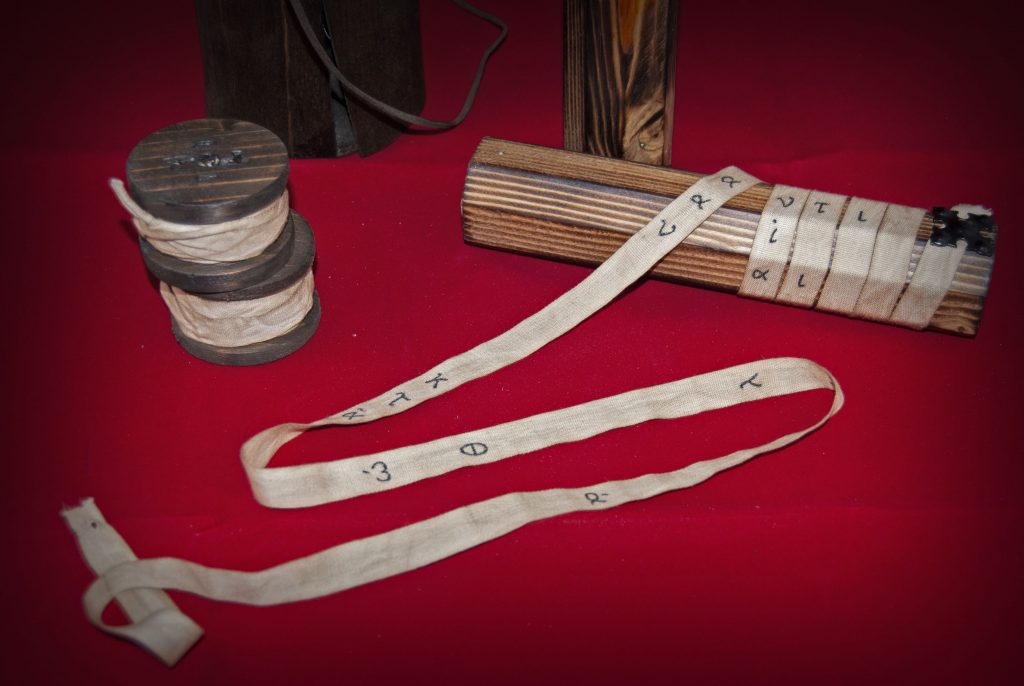From the very moment we discovered the spartan scytale, we were completely captivated: that combination of ingenuity, discretion, and mechanical simplicity immediately sparked our curiosity.
How could the Spartans, over two thousand years ago, have created such an elegant and effective cipher system?
The spartan scytale (Greek: skytálē) is essentially a cryptographic device used by the Spartan ephors to send secret messages, and its logic strikes us as both brilliant and poetic.

Its operation was surprisingly simple yet ingenious: two rods of identical thickness were required and given to the participants in the communication.
To send a message, a strip of parchment or paper was wound spirally around one of the rods, and the message was written lengthwise, so that each turn of the strip contained only a fragment of the text.
Once the message was complete, the strip was unrolled and sent to the recipient, who only needed to wrap it around the matching rod for the letters to align and reveal the original message.

Plutarch provides a detailed description of the spartan scytale in his Life of Lysander:
“The scytale works as follows: when the ephors send someone to command the fleet or as a general, they cut two round pieces of wood, perfectly equal in diameter and thickness, so that the cuts correspond exactly. They keep one and give the other to the appointed person; these pieces are called scytalae.
When they wish to communicate something secret and important, they form a long, narrow strip of paper, and fit it to the piece of wood they keep, leaving neither excess nor shortage, so that the paper perfectly covers the rod. Once this is done, they write on the paper while it is wrapped around the scytale. After writing, they remove the paper and send it to the general without the rod. The recipient cannot make sense of the letters alone, as they appear disconnected; but taking their scytale, they wrap the strip around it, aligning the letters in order, and the full message appears as intended.”
We were fascinated imagining generals and ephors handling these rods and strips of paper, feeling the tension of a secret message that could only be read with the correct scytale. That mix of mystery, precision, and mechanical simplicity inspired us to create our own handcrafted reproduction, which you can now explore and enjoy.

Our reproduction is presented in a flexible wooden box that protects and highlights each component:
-
Two wooden scytalae, approximately 20 cm long and 4 cm thick, each with two nails to hold the strip in place. Holding them in your hands creates a tangible connection to antiquity.
-
One strip of aged cotton with the Greek inscription: “Athens has been conquered”. From the moment we saw these letters, we were filled with a mix of curiosity and awe; being able to touch a phrase that evokes history is a truly captivating experience.
-
Two rolls of blank cotton strips, exactly the right length to cover the scytale, allowing new inscriptions to be created and enabling interaction with the system just as the ancient Spartans did.
As each piece is handmade, every reproduction is unique. Slight variations in color, texture, or shape are not flaws but part of their charm and authenticity: each scytale has its own personality, just like in classical Greece.
Since discovering this ingenious cipher method, we have felt an almost magnetic attraction: it is a window into a past where history, strategy, and creativity intertwined in objects as simple as a rod and a strip of paper. We hope this reproduction awakens in you the same fascination and curiosity that captivated us from the very first moment.
https://mj2artesanos.es/en/archeology-and-mystery/110-spartan-scytale.html


Leave a Reply